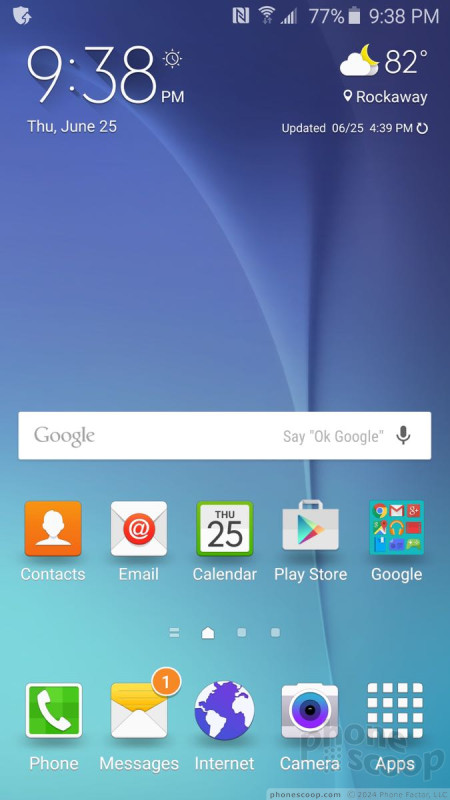Review: Samsung Galaxy S6 Active for AT&T
Note: Since the Galaxy S6 Active is similar in terms of features to the S6 and S6 Edge, portions of this review have been carried over from our other reviews of the S6 and S6 Edge.
Menus
Android 5.1 Lollipop is the underlying operating system, but Samsung slathered its TouchWiz user interface on top. The basics — lock screen with app shortcuts, notification shade, home screen panels, widgets, app menu, settings tools — are all more or less in place. Samsung dressed most of these core elements up with its own design language, but the way they function is the same as most other Android devices.
The lock screen includes shortcuts to the phone and camera. It's worth noting that the app menu displays items in alphabetical order and supports folders, but you can't uninstall apps. Samsung adopted the same silly “3D” parallax effect (apps move against the background) that Apple did when it introduced iOS 7. I couldn't find a way to turn it off. The notification shade and settings menus rely on the same circle-centric design we saw on the GS5 last year and are rather clunky in their layout. Otherwise, it's Android.
If you're looking to personalize the Active, you have plenty of options. There are a wide variety of wallpapers, alerts, ringers, and widgets. You can also set fonts, text sizes, and control many different aspects of the display. One new thing I really like: you can choose how many app shortcuts and/or widgets will fit on a single home screen panel. For example, the base configuration is four across and four down for a total of 16 shortcuts per home screen. You can alter the grid to a 4x5 configuration or a 5x5 configuration to fit more apps/widgets, if that's how you roll. That's pretty cool. (HTC offers this option as well.)
Samsung still thinks everyone loves Flipboard Briefing and has made it the left-most home screen panel. Samsung hopes people will use it as a socially-connected newsreading platform, much like HTC's BlinkFeed in Sense. You can get rid of it if you want, which is what I did. I replaced it with Google Now.
The other big addition to TouchWiz is themes. Like the themes in HTC's Sense UI, the themes in TouchWiz completely alter the look and feel of the user interface elements. For example, all the app icons, fonts, and colors are different within each theme. Only three themes are pre-loaded: the bluish one we've seen on many Galaxy phones; a pink theme (for girls?); and a space theme that turns your smartphone into an "Adventure Time"-like alternate universe (seriously, it's bonkers). There are dozens more available for download, but, annoyingly, you have to create a Samsung ID/account in order to access them.
The Active includes support for Samsung's split-screen mode, which allows two apps to function in separate windows at the same time. It's fairly easy to activate, and a decent number of apps work with the feature, such as the browser, Gmail, YouTube, messaging, and so on. It's a cinch to drag content from one live window to another, and otherwise interact with the multiple windows. This is a useful feature I wish more smartphone makers would adopt.
The Active offers Samsung's Easy Mode, which dumbs down the user interface for beginners. It's no doubt useful for people who might otherwise be overwhelmed by TouchWiz, but for goodness sake buy something cheaper if you need to use Easy Mode.
Samsung kicked Qualcomm's Snapdragon processors out of its premium device in favor of its own Exynos-branded chips. The Active has an octa-core processor with four cores at 2.1 GHz and four cores at 1.5 GHz in a big.LITTLE configuration. The processor is paired with 3 GB of RAM. After spending nearly a few days with the phone, all I can tell you is that the device does everything in a blink.
Calls and Contacts
Samsung's phone app is a slight variation on the Lollipop phone app. Samsung's app is easier to use, in my opinion, and looks better too. The default screen is the dialpad, but tabs across the top will take you to your call log, favorites, or contacts. In-call options run the norm. Like most Galaxy-branded handsets, the Active offers extensive control over the minutia of the phone app. For example, you can define call rejection behaviors and whether or not it automatically sends text messages. You can choose to automatically reject all calls from select numbers, how the phone answers calls (press the home button, using voice commands, etc.), and even automatically answer all calls when connected via Bluetooth.
There are several gestures for interacting with the phone app. For instance, if you're viewing a contact, raising the phone to your head will automatically call that person's main number. If you've missed calls or messages the phone will vibrate when picked up. Placing your hand over the display or turning the phone over will silence incoming calls.
Sadly, the phone doesn't support WiFi calling or VoLTE.
The contact app is practically the stock Android version. Samsung gave it a fresh coat of paint, but otherwise it functions as we've come to expect. When you open the actual contact app, the default view is all contacts. There are tabs for reaching your favorites and/or groups. All the graphical elements are fitted into colorful circles and it is certainly bright. Individual contact cards hold tons of data these days, and the phone can easily sync with pretty much any internet-based contact database (Gmail, Outlook, Yahoo, Exchange, etc). You can also merge your social networking contacts into the fold and even choose to view only your Gmail contacts, your Facebook contacts, and so on.
Messaging
Gmail is on board, as is the no-longer-relevant Android email app. Gmail handles all types of email accounts these days so the other email app is just a waste of space. AT&T has placed its own AT&T Mail app aboard, as well, though why you'd use it is beyond me.
As far as text messaging goes, the Active only includes the older Android SMS application. I don't know why the newer Messenger app (SMS) from Google isn't on board, but you can snag it from the Play Store quite easily.
The Active also has Google's Hangouts app, which handles SMS and IM together, if you wish. Google+ is installed, but Facebook, Twitter, and Facebook Messenger are all absent.






























 Hands On with Samsung Galaxy S6 Active
Hands On with Samsung Galaxy S6 Active
 AT&T Intros the Samsung Galaxy S6 Active
AT&T Intros the Samsung Galaxy S6 Active
 Qualcomm Taps Iridium for Satellite Connectivity
Qualcomm Taps Iridium for Satellite Connectivity
 iPhone 15 Series Goes All-In on USB-C and Dynamic Island
iPhone 15 Series Goes All-In on USB-C and Dynamic Island
 Samsung Galaxy S6 active
Samsung Galaxy S6 active








